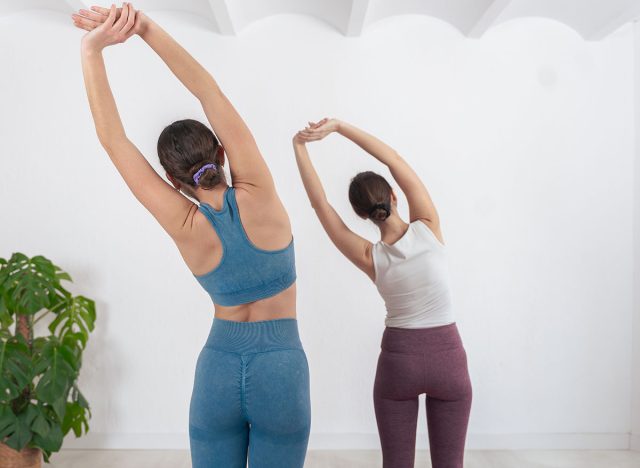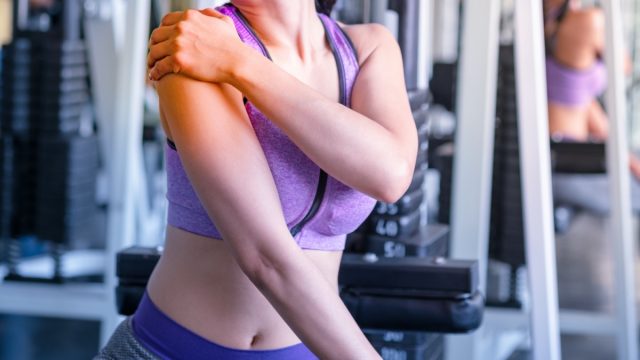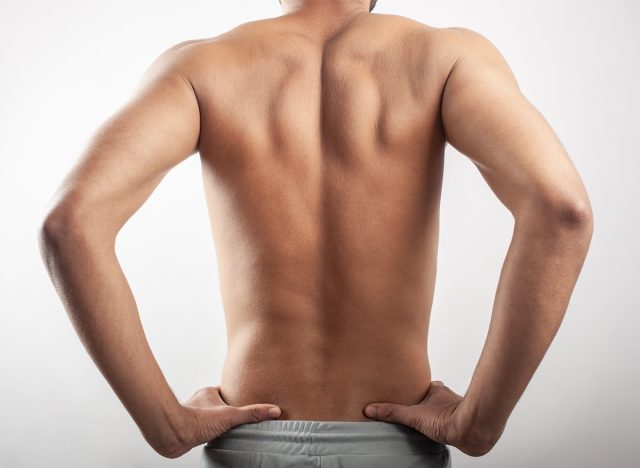If You Can Pass These 3 Shoulder Tests, Your Mobility Is Top-Tier

Keeping your shoulders in good shape is essential. After all, we pretty much use them all day long. Healthy shoulders are important when it comes to moving efficiently, but also to prevent joint, muscle, and even postural difficulties. To help you determine your shoulder mobility, we’re here with three tests. If you can’t perform the below exercises, you need to boost your shoulder mobility.
Why Shoulder Mobility Matters
“The shoulder is a ball-and-socket joint, providing a highly versatile range of motion across all three planes of movement—flexion/extension, abduction/adduction, and internal/external rotation. This extensive mobility allows the shoulder to participate in virtually every activity of daily life, such as bathing, dressing, driving, exercising, and working,” explains Raymond Erpe, master flexologist for StretchLab. “From reaching overhead to pushing, lifting, and rotating, the shoulder is constantly engaged in a variety of functional movements.”
Your shoulders are constantly on the move. Ramond explains how much of a role they play in solid body posture—and how much havoc they can cause if their mobility is compromised.
“When the shoulders become rounded, it often results in a forward-flexed posture, which shifts the alignment of the spine,” he tells us. “This misalignment places unnecessary strain on the spine, particularly in the neck, thoracic, and lumbar regions, which can lead to a range of musculoskeletal problems over time. Fun fact, for every inch the head moves forward, it roughly adds 10 pounds to your neck!”
What Happens When Shoulder Alignment Fails
There are several factors that can contribute to shoulder/postural problems, the main ones being poor ergonomics and long periods of static positioning.
“Sitting at a desk for extended hours, frequently using your phone, or slouching while standing or walking all exacerbate the tendency for rounded shoulders,” Raymond explains. “Additionally, improper body mechanics during activities like lifting—such as failing to engage the core or rounding the back—can further stress the shoulders and spine.”
Now comes that “chain reaction.”
“This poor posture creates a chain reaction, shifting the center of gravity forward, which overloads the spine and disrupts its natural curves,” Raymond points out. “The added strain can lead to muscle imbalances, joint dysfunction, and potentially chronic pain, all of which compromise overall spinal health. Addressing these issues early by incorporating regular posture correction, strengthening exercises, and proper lifting techniques can significantly reduce the risk of long-term damage.”
Now that you have a solid understanding of how important your shoulder mobility is, you can try these three mobility tests Raymond put together.
Three Ways To Test Your Shoulder Mobility
Now that you have a solid understanding of how important your shoulder mobility is, you can try these three mobility tests Raymond put together.
Active Range of Motion

Assess if you have a full range of motion as you reach overhead, out to each side, rotating horizontally (crossing your arm across the body—on both sides).
Palpation of the Shoulder Girdle

Look for any asymmetry, swelling, tenderness, pain, and/or swelling.
“Check the AC and SC joint, rotator cuff insertion points on the humerus, anterior shoulder area around deltoids, and biceps tendon,” Raymond says.
Manual Muscle Tests

Test the pectoralis Major/minor, latissimus dorsi, rhomboids, rotator cuff, deltoids, and traps.
What To Look for When Performing the Tests
Raymond tells us the easiest way to determine your shoulder mobility during the tests is to compare both sides visually, and assess your functional movement ability.
He suggests, “Compare your left vs. right side with all movements and [look] for compensation patterns: Do they move the same way?”
Another red flag is limited neck mobility.
“If neck movement is restricted, it could indicate that tight or overactive shoulder muscles are limiting the neck’s range of motion,” Raymond says. “A stiff neck can also be a sign of poor shoulder posture or alignment.”